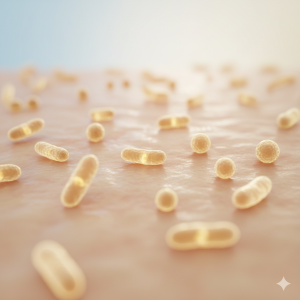Hello,
As specialists dedicated to helping you achieve your best-ever skin, we spend a lot of time discussing advanced treatments, medical-grade skincare, and powerful active ingredients. And while these are incredibly effective tools, I want to talk about a fundamental secret to a truly radiant complexion that no cream or serum can provide on its own. It’s a secret that lies deep within you—in your gut.
You may have heard the term ‘gut health’ becoming more popular, but what does it really have to do with the persistent redness on your cheeks, the stubborn acne on your jawline, or your skin’s overall lack of lustre? The answer is: everything. Welcome to the world of the Gut-Brain-Skin Axis, a powerful, interconnected system that dictates the health and appearance of your skin.
The Science Made Simple: Your Body’s Internal Super-Highway
Think of your gut as a bustling metropolis, home to trillions of microorganisms known as your microbiome. This isn’t just a simple digestive tube; it’s so complex that scientists now refer to it as our “second brain.” This second brain is in constant, direct communication with your main brain via a super-highway called the vagus nerve.
This is the Gut-Brain Axis. When your gut is happy and its microbiome is balanced, it sends calming, positive signals to the brain. When it’s unhappy—due to poor diet, stress, or antibiotics—it sends out distress signals.
But here’s the fascinating part: the skin is also a key player in this conversation. It’s our body’s largest organ and a highly visible indicator of what’s happening internally. Stress signals from the brain and inflammatory signals from an imbalanced gut can manifest directly on your skin. This three-way communication network is the Gut-Brain-Skin Axis.
The Troublemakers: How Gut Imbalance Sabotages Your Skin
When the delicate balance of your gut microbiome is disrupted (a state called dysbiosis), two major problems arise that directly impact your complexion:
- Systemic Inflammation: A healthy gut has a strong, secure lining. In a state of dysbiosis, this lining can become compromised, a condition often called “leaky gut.” This allows tiny, undigested food particles and toxins to “leak” into your bloodstream. Your immune system identifies these as invaders and launches a full-body inflammatory response. This chronic, low-grade inflammation is a primary trigger for conditions like acne, rosacea, eczema, and psoriasis. It’s your body’s alarm system, and the red alert is flashing on your skin.
- Poor Nutrient Absorption: Your skin requires a steady supply of vitamins and minerals (like Zinc, Vitamin A, and antioxidants) to repair itself, build collagen, and fight off environmental damage. An unhealthy gut is inefficient at breaking down food and absorbing these vital nutrients. You could be eating the most nutritious diet in the world, but if your gut can’t absorb it, your skin will be starved of the building blocks it needs to glow.
A Quick Case Study:
I once worked with a client, let’s call her Sarah, in her early 30s. She had spent thousands on topical treatments for persistent adult acne and rosacea with minimal, temporary success. During our consultation, she mentioned she also suffered from frequent bloating and “brain fog.” This was a classic sign that we needed to look deeper than her skin’s surface. By focusing on healing her gut, we were able to calm the internal inflammation that was driving her skin issues. The topical treatments then became far more effective because we were no longer just fighting the symptoms; we were addressing the root cause.
Your Actionable Plan: Nourish Your Gut, Feed Your Skin
The good news is that you have a tremendous amount of control over your gut health. Here are actionable, doctor-approved tips you can start today.
1. Bring in the Good Guys (Probiotics):
Probiotics are live, beneficial bacteria that help restore balance to your microbiome. While supplements can be useful, I always recommend starting with food.
- Actionable Tip: Introduce fermented foods into your diet. Start with just a spoonful or two a day.
- Kefir: A fermented milk drink that’s like a supercharged yoghurt. Add it to your morning smoothie.Kombucha: A fermented tea. Look for low-sugar varieties.
- Sauerkraut & Kimchi: Fermented cabbage. Fantastic as a side dish. Ensure you buy the refrigerated kind, as shelf-stable versions are pasteurised, killing the live cultures.
2. Feed the Good Guys (Prebiotics):
Prebiotics are a type of dietary fibre that your beneficial gut bacteria love to eat. Think of them as fertiliser for your internal garden.
- Actionable Tip: Aim to include a variety of prebiotic-rich foods every day.
- Garlic, Onions, and Leeks: These are easy to add as a base to almost any savoury dish.Bananas (especially slightly green ones): A perfect on-the-go snack.Oats: A fantastic breakfast that provides a slow release of energy and prebiotic fibre.
- Asparagus: A delicious side dish packed with skin-loving nutrients.
3. Calm the Command Centre (Your Brain):
Remember, stress is a major player. When you’re stressed, your brain sends signals that can harm your gut bacteria and trigger inflammation.
- Actionable Tip: Incorporate a simple stress-management technique into your daily routine. This isn’t about eliminating stress, but managing your response to it.
- Try five minutes of deep belly breathing before you start your day.Take a 15-minute walk at lunchtime without your phone.
- Practice mindfulness or meditation using a free app.
True, lasting skin health is an inside job. By nurturing your gut, you are creating the fundamental foundation for a clear, calm, and radiant complexion. This journey requires patience, but the results are more than skin deep—they are a reflection of a healthier, more balanced you.




